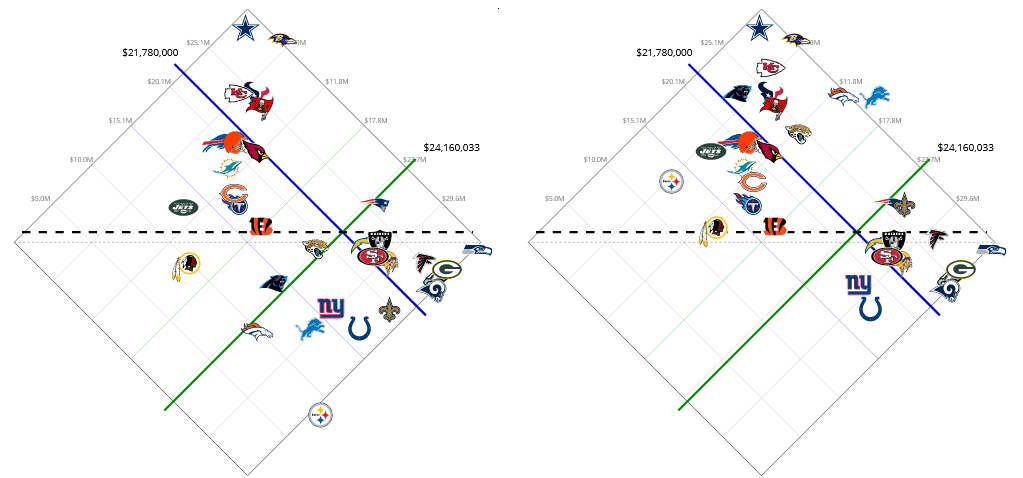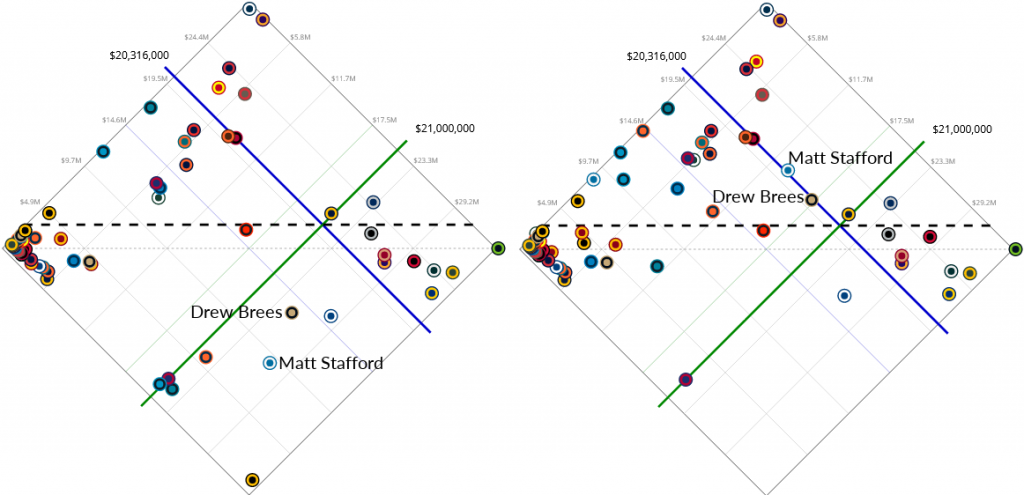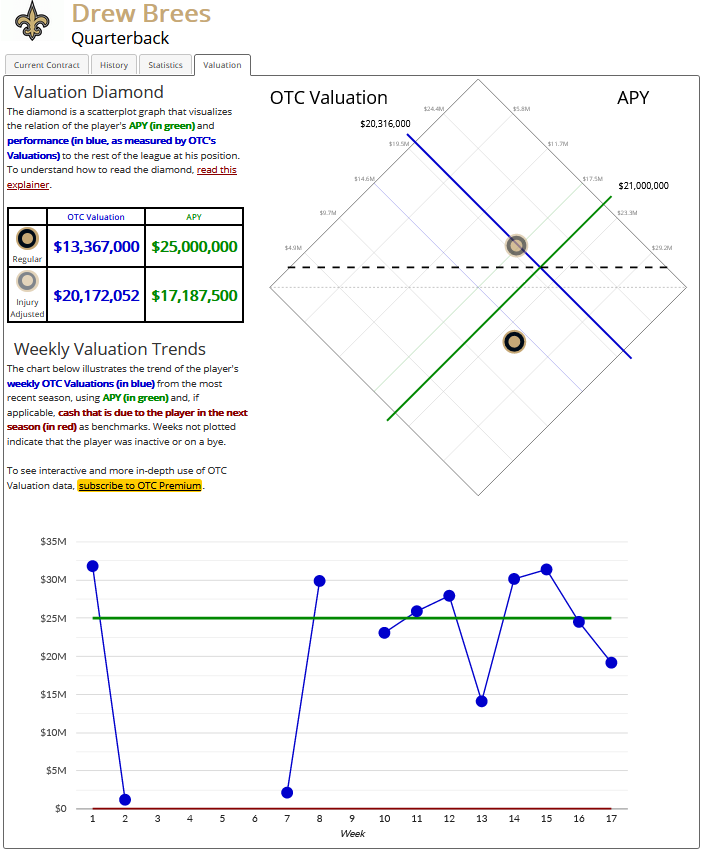I’m happy to introduce several additions and updates to Over The Cap that have been much time in the making. Let’s jump right in to explain what’s new.
Data on games missed, injured or healthy
Injuries are a brutal reality of the NFL. Any financial evaluation of the players’ performance has to account for this reality. Therefore, OTC has compiled new data to track how many games players have missed, and further splitting that data down to whether the player was injured (either placed on a weekly inactive list due to injury, or on Reserve/Injured, Reserve/Physically Unable To Perform, or Reserve/Non-Football Injury/Illness), or was simply a healthy scratch on the weekly inactive list.
There will likely be more usages of this data in the future, but the following describes where it is currently being used.
Games missed are included in statistics
Games missed is now a column in the Statistics tab of each player page. Let’s use Adam Gotsis, a defensive lineman of the Broncos in 2019, as an example:

Gotsis begain the 2019 as a starter at defensive end, but as the team was adjusting to Vic Fangio’s defense, the decision was made to deactivate him as a healthy scratch during Weeks 5-8 in favor of starting Mike Purcell. Gotsis was activated as a backup after then, but then suffered a knee injury around week 15 that sidelined him for the final three games of the season.
Games missed due to injury are included in the depth charts and free agency charts on the premium side
For players that missed games due to injury, a white box with a red number indicating the number of games missed will be included next to their names. This is an upgrade over the previous designation of whether a player finished a season on injured reserve.
The snap counts that sort these charts have also now been adjusted for injury. This should give a more accurate description of who each team really considers starter quality.
Let’s stick with the 2019 Broncos defense as a sample, and particularly note Bradley Chubb:

Chubb played the first four games of 2019 before suffering a season ending ACL tear. Previously, Chubb would have been listed behind other edge rushers, but practically that of course makes little sense, as when Chubb comes back in 2020 he will be presumed to be a starter once again. By similarly presuming that Chubb’s snap counts would have been high if has healthy all season, he is placed in a more proper place on the depth chart.
Injury adjusted season-wide OTC valuations have been added.
In OTC’s Premium section, we have compiled a table of valuations for all players in the league. We now have new columns that adjust these values for injury. This will assist in discovering whether or not a player was performing at a high level when he was healthy enough to play.
The formulas that are used to adjust both the OTC valuation and the APY for injury are as follows:
- Injury Adjusted Value: [OTC Valuation]+[Average of weekly OTC Valuations for games played]*[games lost to injury]/16
- Injury Adjusted APY: [APY]-[APY]*[games lost to injury]/16.
In simpler words, the injury adjusted data adds an estimate of the hypothetical value the player would have contributed in games missed to injury, while also subtracting from the APY the games the player missed.
The 2019 season of Drew Brees is an excellent example. Brees’s regular OTC valuation came in at $13.4 million APY, a far cry below his APY of $25 million. However, this was due to Brees missing five games from a thumb injury. Adjusting those numbers using the formula above gives Brees an OTC valuation of $20.2 million against an APY of $17.2 million, representing a value over APY that is still positive.
The valuation diamond has been created to help visualize OTC’s valuation metric.
A long textual list of numbers can sometimes be exhausting, so to aim to aid those who learn better through graphics, we’ve created the valuation diamond. In its simplest terms, the diamond is a scatterplot graph that visualizes the relation of a player’s APY and performance to the rest of the league at his position.
Since viewing the diamond might be a bit daunting at first, I highly recommend that you first read this explainer to reach a better understanding.
Generally speaking, each team wants to find itself and its players in the top quadrant as much as possible (high performance, low compensation) and similarly avoid the bottom quadrant (low performance, high compensation) as much as possible. Like the valuation tables, the diamond also has an option to adjust for injury in order to reach better insight.
The diamond can be displayed in a team view, aggregating all the team’s players at that position together, and in a player view, which displays the players as individual data points.
Here is an example of the team view for 2019 at quarterback, with the regular values at the left, and the injury adjusted values at the right:

And, borrowing from the explainer, here are diamonds from the player view at 2019 quarterback, with specific emphasis on Brees and Matt Stafford:

The team view of the diamond from the most recent NFL season can be found publicly here. The player view can be found in OTC’s Premium section.
A new Valuation tab has been added to each player page
Finally, you may now view several aspects of players’ OTC valuation on each of their player pages. Let’s stick with Brees as an example of what you will see:

- First, you will see a table highlighting the player’s regular and injury adjusted OTC valuation and APY.
- Second, you will see a diamond dedicated just to the selected player as to where the above values lie as compared to his peers at his position.
- Finally, we’ve added a Weekly Valuation Trends chart that shows how the player’s performance as measured by the weekly OTC values is trending. Also included are benchmark lines of his APY, and how much cash he is due in the next season. (In Brees’s case, since he’s a pending free agent, the cash line for him is at $0.)
* * * *
I hope that these new features will help readers learn more about contracts in the NFL as we approach the start of the next league year. There is much that has been added and discussed here, so if you have any questions or comments, do not hesitate to reach out by e-mail or by Twitter.